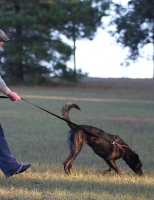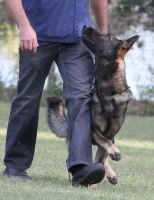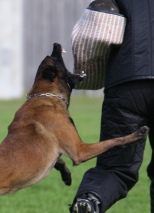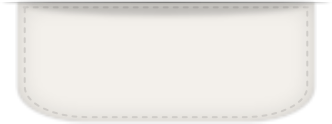What is IPO / Schutzhund?
Schutzhund (German for "protection dog") is a dog sport that was developed in Germany in the early 1900s as a breed suitability test for the German Shepherd Dog. The test would determine if the dog displayed the appropriate traits and characteristics of a proper working German Shepherd Dog. Today, it is used as a sport where many breeds other than German Shepherd Dogs can compete, but it is a demanding test for any dog.
Schutzhund tests dogs of all breeds for traits such as a strong desire to work, courage, intelligence, trainability, a strong bond to the handler, perseverance and protective instincts. It also tests for physical traits such as strength, endurance, agility, and scenting ability. The goal of Schutzhund is to illuminate the character and ability of a dog through training. Breeders can use this insight to determine how and whether to use the dog in producing the next generation of working dogs.
Dogs of any breed, even mixes, compete in Schutzhund, but the most common breeds are German Shepherds, Belgian Malinois, Boxers, Rottweilers, Dobermans, Cane Corso, Giant Schnauzers, Bouvier des Flandres, Dutch Shepherd Dogs, Beaucerons, American Bulldogs, Black Russian Terriers, Airedale Terriers, Australian Cattle Dogs, and the like.
In 2004 the Verein für Deutsche Schäferhunde (SV) and the Deutscher Hundesportverein (dhv) made substantial changes to Schutzhund rules. The dhv adopted the Fédération Cynologique Internationale (FCI) rules that govern IPO titles. The dhv changed the name of the titles from "SchH" (Schutzhund) to IPO, (International Prufungorden - which roughly translates into international working tests.)
Schutzhund is governed by a number of organizations. The FCI, the international umbrella organization for all things dog related, sets the rules for IPO titles. The AZG sets the rules for Schutzhund for all breeds. The AZG is one of the component organizations of the VDH, the all breed kennel club of Germany. DVG is an all-breed dog sport organization in Germany that organizes clubs and trials and has branches in Canada and The United States.
A function of Schutzhund clubs is to also identify dogs that should not be trained in the sport. Schutzhund is a challenging test of a dog's character, and not every dog is up to the challenge. The training director of the club has a responsibility to the dog, handler, club, and society to constantly evaluate every dog and to decline to train any dog with questionable character or working ability. Training a dog that does not really want to work is stressful and frustrating for all parties involved. Schutzhund clubs regularly hold public trials, providing the opportunity for dogs to earn titles and for handlers to assess their training progress. A good club should be considered a necessity for Schutzhund training.
There are three Schutzhund titles: IPO 1, 2 and 3. IPO 1 is the first title and IPO 3 is the most advanced. Additionally, before a dog can compete for an IPO 1, he must pass a temperament test called a BH (Begleithundprüfung, which translates as "traffic-sure companion dog test"). The BH tests basic obedience and sureness around strange people, strange dogs, traffic, and loud noises. A dog that exhibits excessive fear, distractibility, or aggression cannot pass the BH.
The Schutzhund test has changed over the years. Modern Schutzhund consists of three phases: tracking, obedience, and protection. A dog must pass all three phases in one trial to be awarded an IPO title. Each phase is judged on a 100-point scale. The minimum passing score is 70. At any time the judge may dismiss a dog for showing poor temperament, including fear or aggression.
DVG stands for Deutscher Verband der Gebrauchshundsportvereine, or the German Association of Working Dog Sport Clubs. DVG is the oldest and largest Schutzhund training organization in the world. Begun in 1903, DVG was Germany's first police and service dog club and has now grown to nearly 30,000 members. DVG exists for only one purpose -- training and titling dogs of all kinds. In addition to Schutzhund and advanced tracking degrees, it offers obedience and tracking titles, providing competition opportunities for all people who love to train dogs, even the smallest of breeds.
DVG is made up of fourteen geographic regions (Landesverbands), thirteen of which are in Germany. The fourteenth is LV DVG America. The American Landesverband is divided into four local regions (Kreisgruppen), whose presidents sit on the LV Board.
LV DVG America sends a representative to Germany each year to the annual business meeting to vote on Board and membership affairs.








































































































































































































































































































































































































































































































